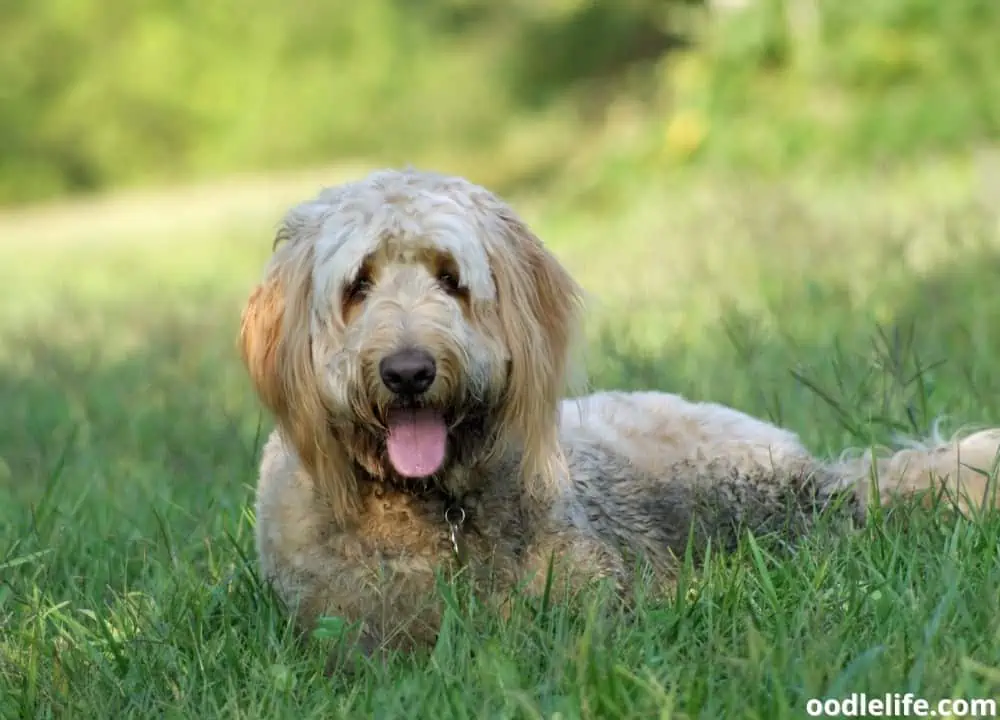Goldendoodle Health Issues and Prevention
With their floppy ears and heart-melting eyes, Goldendoodles are one of the most popular hybrid designer dogs. The adorable cross of a Golden Retriever and a Poodle, Goldendoodles are wonderful companion dogs that can suit most households, even those with young children.
However, hybrid dogs come with the genetic predisposition of both the parent breeds, which means Goldendoodles are vulnerable to health issues of both the Golden Retriever and the Poodle.

In this blog post, we’ll look at all the health issues that Goldendoodles face and what you can do to help prevent them.
1. Hip Dysplasia
Hip dysplasia is a common condition that affects dogs of all breeds, but in particular, larger dogs. The condition occurs when the ball and socket of the hip joint do not fit together properly, causing the joint to rub and grind instead of gliding smoothly. This can lead to pain, lameness, and eventually arthritis.

While there is no cure for hip dysplasia, there are several treatment options available that can help improve your dog’s quality of life. Surgery is an option for some dogs, but weight management, exercise, and joint supplements are often recommended as initial treatments. If your dog has been diagnosed with hip dysplasia, talk to your veterinarian about the best way to manage the condition and keep your furry friend comfortable.
While there is no cure for hip dysplasia, there are several things that dog owners can do to help prevent it. First, avoid feeding your dog table scraps or high-fat foods. Excess weight puts unnecessary strain on the hips and can make existing dysplasia worse.
Second, provide your dog with plenty of exercise. This helps to keep muscles strong and joints flexible. Third, choose a dog food that is rich in omega-3 fatty acids.
These help to reduce inflammation and keep joints healthy. By following these simple tips, you can help to prevent hip dysplasia in your dog.
2. Progressive Retinal Atrophy (PRA)
Progressive retinal atrophy (PRA) is a degenerative eye disease that affects both dogs and cats. It occurs when the photoreceptor cells in the retina gradually break down, leading to blindness. There are many different causes of PRA, but the most common is genetic.

Some breeds are predisposed to PRA, but any dog or cat can develop the disease as they age. There are two main types of PRA: central and peripheral. Central PRA affects the central vision first, while peripheral PRA starts in the outer edges of the retina and moves inward.
There is no cure for PRA, but there are treatments available to help delay its progression. If you think your pet may be developing PRA, it is important to contact a veterinarian as soon as possible. With early intervention, you can help your pet maintain its vision for as long as possible.
One of the most important things you can do is to have your dog’s eyes examined regularly by an ophthalmologist. If PRA is detected early, treatments such as nutritional supplements and low vision aids can help slow its progression. In addition, regular exercise and a healthy diet can help to delay the onset of PRA in dogs who are at risk for the disease.
3. Patella Luxation
Patellar luxation is a condition that affects the kneecap (patella) of dogs. In normal anatomy, the patella sits in a groove at the end of the femur (thighbone). However, in dogs with patellar luxation, the patella is dislocated from this groove, resulting in pain and lameness.

Treatment usually involves surgery to stabilize the patella in its proper position. In severe cases, however, the patella may need to be removed (patellectomy). Patellar luxation is a relatively common condition in dogs, especially small breeds.
If you think your dog may have patellar luxation, please consult your veterinarian. Early diagnosis and treatment can help to minimize pain and improve your dog’s quality of life.
There are a number of different causes of patellar luxation, including congenital abnormalities, traumatic injury, and muscle imbalances. Smaller breeds of dogs are also more prone to developing this condition. While patellar luxation can occur in any dog, there are steps that can be taken to help prevent it.
For example, exercise and weight management are important for maintaining muscle balance and joint health. Similarly, regular checkups with a veterinarian can help to identify early signs of patellar luxation so that treatment can be started immediately.
4. Legg-Calve-Perthes Disease
Legg-Calve-Perthes disease is a condition that affects the hip joint. The hip joint is a ball-and-socket joint, and Legg-Calve-Perthes disease occurs when the ball portion of the joint does not develop properly. This can cause pain, stiffness, and decreased range of motion in the affected hip.

There is no known cure for Legg-Calve-Perthes disease, but there are treatments that can help to reduce pain and improve the range of motion.
There are several steps that dog owners can take to help prevent the disease, including:
Maintaining a healthy weight – Excess weight can put a strain on the hips and increase the risk of developing Legg-Calve-Perthes disease.
Providing plenty of exercise – Exercise helps to keep the muscles around the hip joint strong and can help to prevent the onset of Legg-Calve-Perthes disease.
Avoiding injury – Traumatic injuries to the hip joint can increase the risk of developing Legg-Calve-Perthes disease. Dog owners should take care to protect their dog’s hips from injury.
5. Thyroid Issues – Hypothyroidism and Hyperthyroidism
Thyroid issues can affect dogs of any age, though it is most common in middle-aged to senior dogs. The thyroid gland produces hormones that regulate the body’s metabolism, and when the gland doesn’t produce enough of these hormones or produces too much, it can lead to a variety of symptoms.

These can include weight gain, lethargy, dry skin and coat, hair loss, cold intolerance, and more. If left untreated, hypothyroidism can cause serious health problems, including heart disease and infertility. If you suspect that your dog may have a thyroid problem, it’s important to take them to the vet for a check-up.
Thyroid problems can be caused by a number of different things, including autoimmune disease, infection, tumors, or simply an imbalance of hormones. Thankfully, most thyroid problems can be effectively treated with medication.
There are a few simple things we can do to help prevent thyroid issues in our dogs. First, make sure they get plenty of exercise. A daily walk or run will help keep their metabolism active and prevent weight gain.
Second, feed them a healthy diet. Avoid processed foods and make sure they’re getting plenty of fresh fruits and vegetables. Lastly, visit the vet regularly for check-ups.
This will help catch any problems early and give your dog the best chance for a long and healthy life.
6. Cancer
Unfortunately, cancer is a common disease in dogs, and Golden Retrievers are particularly susceptible to this devastating disease. While the exact cause of cancer in dogs is unknown, there are some risk factors that may contribute to its development.

For example, older dogs are more likely to develop cancer than younger ones, and certain breeds are more prone to the disease than others. However, the good news is that there are many treatment options available for dogs with cancer. With early diagnosis and proper treatment, many dogs can go on to live long and healthy lives.
While there is no guaranteed way to prevent cancer in dogs, there are some steps we can take to reduce the risk. First, make sure your dog is up-to-date on all vaccinations, as this will help to boost its immune system. Second, feed your dog a healthy diet rich in lean proteins and antioxidants.
Third, keep them active with regular exercise, as this will help to maintain their weight and muscle tone. Finally, avoid exposure to toxins by keeping them away from cigarette smoke and cleaning up any chemicals or pesticides that they may come into contact with.
7. Epilepsy
Epilepsy is a neurological disorder that can affect dogs of all breeds and ages. The most common type of epilepsy in dogs is idiopathic epilepsy, which occurs without an underlying cause. Symptoms of epilepsy can vary from dog to dog, but may include things like seizures, loss of consciousness, drooling, and muscle twitching.

Epilepsy can be a frightening experience for both dogs and their owners, but there are steps that can be taken to prevent it. Proper nutrition and exercise are important for all dogs, but especially those who are susceptible to seizure activity. In addition, it is important to avoid potential triggers like loud noises or flashing lights.
8. Von Willebrand’s Disease
Von Willebrand’s Disease is a bleeding disorder that can be fatal for dogs. The disease is caused by a lack of a protein that helps blood clot. As a result, affected dogs often bleed excessively from even minor injuries.

Von Willebrand’s Disease is hereditary, and there is no cure.
However, the disease can be managed through treatment. One way to help prevent Von Willebrand’s Disease in dogs is to have them tested for the disease before breeding them. If both parents are carriers of the disease, there is a 25% chance that their puppies will develop the disease.
However, if only one parent is a carrier, there is only a 6.25% chance that their puppies will develop the disease. By having your dog tested before breeding, you can help to decrease the chances of passing on this fatal disease.